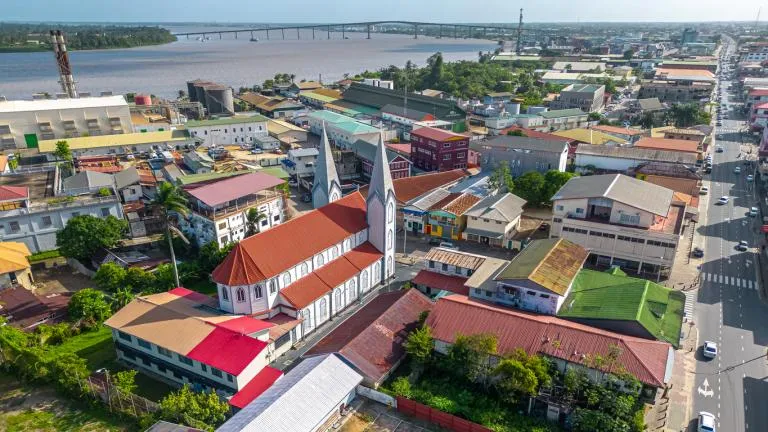Hire anywhere—No entity required
Start hiring nowSo here’s what happens when global companies start looking beyond their borders. They discover places like Cambodia. Not the Cambodia of history books or old headlines, but today’s Cambodia, a country where nearly 10 million people make up one of Southeast Asia’s fastest-growing workforces.
You’re scaling your business and need talent that’s both skilled and cost-effective. You want people who can adapt, who speak multiple languages, and who understand both local markets and global demands. Hiring in Cambodia delivers on all fronts. The economy is projected to grow 6% in 2025, fueled by manufacturing expansion and a tourism rebound. That kind of growth creates opportunity. It also creates a talent pool that’s hungry, motivated, and increasingly sophisticated.
But here’s the fascinating contradiction at the heart of Cambodia’s job market. A recent skills gap study found that 62% of companies plan to expand their workforce, yet 74% struggle to find qualified candidates. That sounds like a problem until you flip the perspective. What it really means is that companies smart enough to look beyond traditional hiring hubs are snatching up the best talent.
Cambodia’s employment rate is forecasted to hit 79.66% in 2025. Young professionals are increasingly bilingual. Tech sectors are booming. Women are moving into leadership roles at unprecedented rates.
This is a workforce in transition, caught between Cambodia’s agricultural past and its digital future. And that transition creates exactly the kind of opportunity that savvy companies learn to recognize before everyone else does.
What does Cambodia’s labor market look like?
Cambodia isn’t your grandfather’s agricultural economy anymore. While farming still employs many Cambodians, industry now accounts for less than 27% of total employment. Manufacturing, construction, and digital services are driving growth, with hiring in these sectors jumping 25% above pre-COVID levels. The garment sector that once defined Cambodia’s export economy is now sharing space with tech startups, logistics companies, and renewable energy projects.
The skills landscape tells a story of rapid transformation. Nucamp reports that web development tops job postings at 31%, while mobile app development is projected to generate $0.7 billion for the economy by 2029. What’s fascinating is that 72% of companies have already adopted AI technologies, but only one-third have staff trained in AI risk management. That gap represents both challenge and opportunity.
Post-pandemic Cambodia looks fundamentally different from what came before. Remote work has become normal. Digital-first hiring is standard practice. Companies seek employees with hybrid skill sets that combine technical expertise with adaptability.
The gig economy has exploded, creating new pathways for income that didn’t exist five years ago. This is a labor market in the midst of its own digital revolution, unfolding faster than most places and creating precisely the kind of disruption that savvy employers learn to navigate first.
Primary ways to hire employees in Cambodia
So you’ve found the perfect candidate in Cambodia. Now comes the practical question: how do you actually get them on payroll? Foreign companies have two main paths forward, each with distinct trade-offs between control and complexity.
Establishing a legal entity in Cambodia
The traditional route means establishing a Cambodian subsidiary or branch office. This gives you maximum control over operations, hiring, and company culture. You can build a direct relationship with employees and handle everything from contracts to benefits according to your standards.
But here’s the reality check. You’ll need to navigate Cambodia’s foreign employee quota system, which limits foreign staff to 10% of your total Cambodian workforce. That means for every foreign manager or specialist you want to hire, you need nine local employees first.
The Ministry of Labour and Vocational Training requires annual quota applications, work permit processing through their Foreign Workforce Centralized Management System, and compliance with detailed labor law requirements. Companies that skip these steps face fines starting at around $630, plus potential business license issues.
Hiring Cambodian talent through an EOR
The faster, simpler approach enables you to hire Cambodian employees through a local employer of record (EOR) that handles all the regulatory complexities. Your new hires become employees of the EOR on paper, while working exclusively for your company in practice. This eliminates the need for local entity setup, quota applications, and direct compliance management.
The trade-off is less direct control and ongoing service fees. But for companies testing the Cambodian market or hiring small teams, an EOR removes months of setup time and regulatory headaches.
You can have someone working within weeks instead of navigating the six-month process of entity establishment, quota approvals, and work permit bureaucracy. It’s the difference between diving into a new market and slowly wading in through paperwork.
Employment contracts in Cambodia
What surprises most foreign employers is that Cambodia requires written employment contracts for any role lasting longer than two months. No handshake deals. No “we’ll figure it out as we go.” The Labor Law is explicit about this, and violations can trigger fines and legal complications that make your hiring process exponentially more expensive.
The contract must be in Khmer, the native language, even if your employee speaks perfect English. Think of it as Cambodia’s way of ensuring workers understand their rights in their native language. You can include a translated version for your records, but the Khmer version takes legal precedence.
Standard contracts cover salary, job duties, working hours, and termination procedures. Probation periods can last up to three months for most roles, giving both sides time to assess the fit.
One critical detail: Cambodia distinguishes between fixed-term and indefinite contracts, and the rules are different for each. Fixed-term contracts can run for a maximum of two years and require specific justification for renewal. Indefinite contracts offer more flexibility but come with stricter termination requirements. Choose wrong, and you might find yourself stuck with legal obligations you never intended to accept.
Working hours, holidays, and leave
Cambodia’s standard working week caps at 48 hours, typically spread across six days. That’s eight hours Monday through Saturday, which feels foreign to companies accustomed to five-day weeks. Overtime kicks in after those 48 hours, which employers must compensate at 150% of regular wages for the first two hours, then 200% after that.
Annual leave starts at 18 days per year, increasing to 19 days after three years of service. Employees also get special leave for marriage (three days), deaths in the family (up to seven days), and religious observances.
In 2026, Cambodia will recognize 21 public holidays annually (up from 20 currently), including Khmer New Year, Pchum Ben Festival, and Water Festival. During these periods, expect business to slow significantly as these aren’t just calendar dates but deeply cultural celebrations.
Sick leave operates on an interesting sliding scale. Employees get full pay for the first month of illness, half pay for the second month, and no pay thereafter. Maternity leave runs 90 days at full pay, while paternity leave offers 15 days. The government recently expanded family leave provisions, reflecting Cambodia’s push to improve work-life balance as competition for skilled workers intensifies.
Employee benefits and social contributions
Employers must enroll every Cambodian employee in the National Social Security Fund (NSSF) within 30 days of hiring. This covers occupational risk insurance, health insurance, and pension contributions. Employers contribute 2.6% of salary for occupational risk, 2.6% for health insurance, and 2% for pensions. Employees contribute 2.6% for health insurance and 2% for pensions.
The NSSF provides real value to employees. Health insurance covers medical expenses at both public and private facilities. Occupational risk insurance handles workplace injuries and diseases. For international employers, NSSF contributions are non-negotiable and strictly monitored.
Beyond mandatory contributions, competitive employers often add supplemental health insurance, transportation allowances, and meal subsidies. These benefits can make the difference in attracting top talent. Many companies also provide language training, professional development opportunities, and performance bonuses. In a tight labor market, benefits packages often matter more than base salary when candidates are choosing between offers.
Payroll and taxation in Cambodia
Salary payments in Cambodia must happen monthly and in Cambodian Riel, though USD payments are widely accepted in practice. The minimum wage sits at US$208 per month for most sectors, though garment and footwear workers have their own rate of US$204. Professional salaries typically range from US$400 to US$2,000 monthly, depending on industry and experience level.
Tax obligations are split between employer and employee responsibilities. Employees pay progressive income tax starting at 0% on the first US$200 monthly, then 5% on income between US$200 and US$1,250, and 20% on anything above that. Employers must withhold these taxes and submit them monthly to the General Department of Taxation. Fringe benefits like housing allowances and company cars may also be taxable, depending on structure and value.
The Cambodian tax year runs January to December, with final tax returns due by March 31. Payroll taxes, NSSF contributions, and withholding obligations create a monthly compliance calendar that requires careful attention. Miss a deadline or miscalculate contributions, and you’re looking at penalties that can quickly exceed the original tax owed. Most international companies find that working with local payroll providers or EOR services eliminates these compliance headaches while ensuring accuracy.
Termination and severance in Cambodia
Ending an employment relationship in Cambodia is never casual. You need a clear legal basis, written notice, and a final payout that matches the Labor Law.
According to §89-94 of the Labour Law, notice periods for indefinite-term contracts scale with seniority:
- Up to 6 months of service = 7 days’ notice
- 6 months to 2 years = 15 days
- 2 to 5 years = 1 month
- 5 to 10 years = 2 months
- Over 10 years = 3 months
Severance is separate from notice. For dismissals without serious misconduct, employers owe at least seven days of wages for each completed year, capped at six months of salary. Written notice must go to the employee and the Ministry of Labour, and final wages plus unused leave must be paid on the last working day. Penalties for skipping any step can include back pay, fines, and reinstatement orders.
Employee vs. contractor classification
Cambodia’s Labor Law draws sharp lines between employees and contractors, and getting this wrong can cost you. Employees work under direct supervision, follow company schedules, and use company equipment. Contractors operate independently, set their own hours, and typically work on specific projects with defined deliverables. The distinction matters because misclassification triggers back payments for wages, taxes, and NSSF contributions that can stretch back years.
The key test revolves around control and integration. Does the worker report to your office daily? Do they use the company email and its equipment? Are they integrated into your team structure? If yes, they’re likely employees regardless of what your contract says. Contractors should invoice for services, handle their own taxes, and maintain separate business operations. They’re also excluded from Cambodia’s employee protections, like minimum wage, paid leave, and NSSF benefits.
One crucial detail. Cambodia recognizes “labor contractors” as a separate category entirely. “The labor contractor refers to a person who gets work or assignments from the entrepreneur and who himself or herself recruits workers as needed to carry out work or provide any service for a total price,” writes Kanharith Nop, experienced Cambodian employment law attorney.
These are intermediaries who recruit workers for specific projects while remaining responsible for compliance with labor laws. If a labor contractor fails to meet obligations like NSSF registration, the hiring company becomes liable for those workers. This makes due diligence on contractor relationships essential for avoiding unexpected legal exposure.
Work permits and immigration in Cambodia
Foreign workers in Cambodia need both a work permit and proper work visa status, and the application process takes patience. Work permits require a clean criminal background check, medical certification, and proof of qualifications relevant to the job. Employers need to legalize these documents through their home country’s embassy and translate them into Khmer by certified translators.
Cambodia’s foreign worker quota system adds another layer of complexity. Companies can employ foreign staff up to 10% of their total Cambodian workforce, meaning you need at least 10 local employees before hiring your first foreign worker.
Quota applications open annually and require detailed justification for why local workers cannot fill the roles. Applications submitted through the Foreign Workforce Centralized Management System typically take 2-3 months for processing.
Cambodia’s visa requirements vary by nationality and purpose. Most foreign workers enter on business visas that convert to work permits, though some countries have specific bilateral agreements that streamline the process. Work permits are typically valid for one year and renewable, but are tied to specific employers and positions. Change jobs, and you’ll need a new permit. The Ministry of Labour and Vocational Training handles enforcement, and working without proper permits can result in fines, deportation, and blacklisting from future applications.
Hire in Cambodia with Pebl
With Pebl as the legal employer on your behalf, you can skip entity set-up and onboard Cambodian talent in days rather than months. As an EOR in Cambodia, our platform already supports compliant hiring, payroll, and benefits, so adding a software engineer in Phnom Penh feels as easy as adding a teammate next door. Contact us today to learn more.
FAQs: Hiring in Cambodia
The basics of hiring in Cambodia generate predictable questions from international employers. Here are the answers that matter most when you’re moving fast.
What jobs are in demand in Cambodia?
Software developers and IT professionals top the list, with salaries ranging from US$1,000 to US$3,000 monthly as companies accelerate digital transformation. Manufacturing roles are surging across the garment, electronics, and automotive sectors, driven by an 8.6% projected growth rate and increasing foreign investment. Digital marketing specialists, cybersecurity experts, and mobile app developers round out the most wanted positions as Cambodia’s economy modernizes rapidly.
Can I hire Cambodian employees without a local business entity?
Yes, through an employer of record service that acts as the legal employer while your new hires work exclusively for your company. EOR providers handle all compliance, payroll, benefits, and tax obligations, letting you hire Cambodian talent within weeks instead of months. This eliminates entity setup costs, quota applications, and direct regulatory management while maintaining full operational control over your team.
Why is unemployment so low in Cambodia?
Cambodia’s unemployment rate sits at just 0.27%, reflecting an economy where most people work in agriculture, informal sectors, or family businesses that don’t register traditional unemployment. The definition of “unemployed” requires actively seeking work, but many Cambodians create income through subsistence farming, street vending, or gig work that doesn’t appear in official statistics. Additionally, rapid economic growth across manufacturing and services means available jobs often get filled quickly, keeping formal unemployment minimal even as the economy transforms.
This information does not, and is not intended to, constitute legal or tax advice and is for general informational purposes only. The intent of this document is solely to provide general and preliminary information for private use. Do not rely on it as an alternative to legal, financial, taxation, or accountancy advice from an appropriately qualified professional. The content in this guide is provided “as is,” and no representations are made that the content is error-free.
© 2025 Pebl, LLC. All rights reserved.
Topic:
Country Guides


